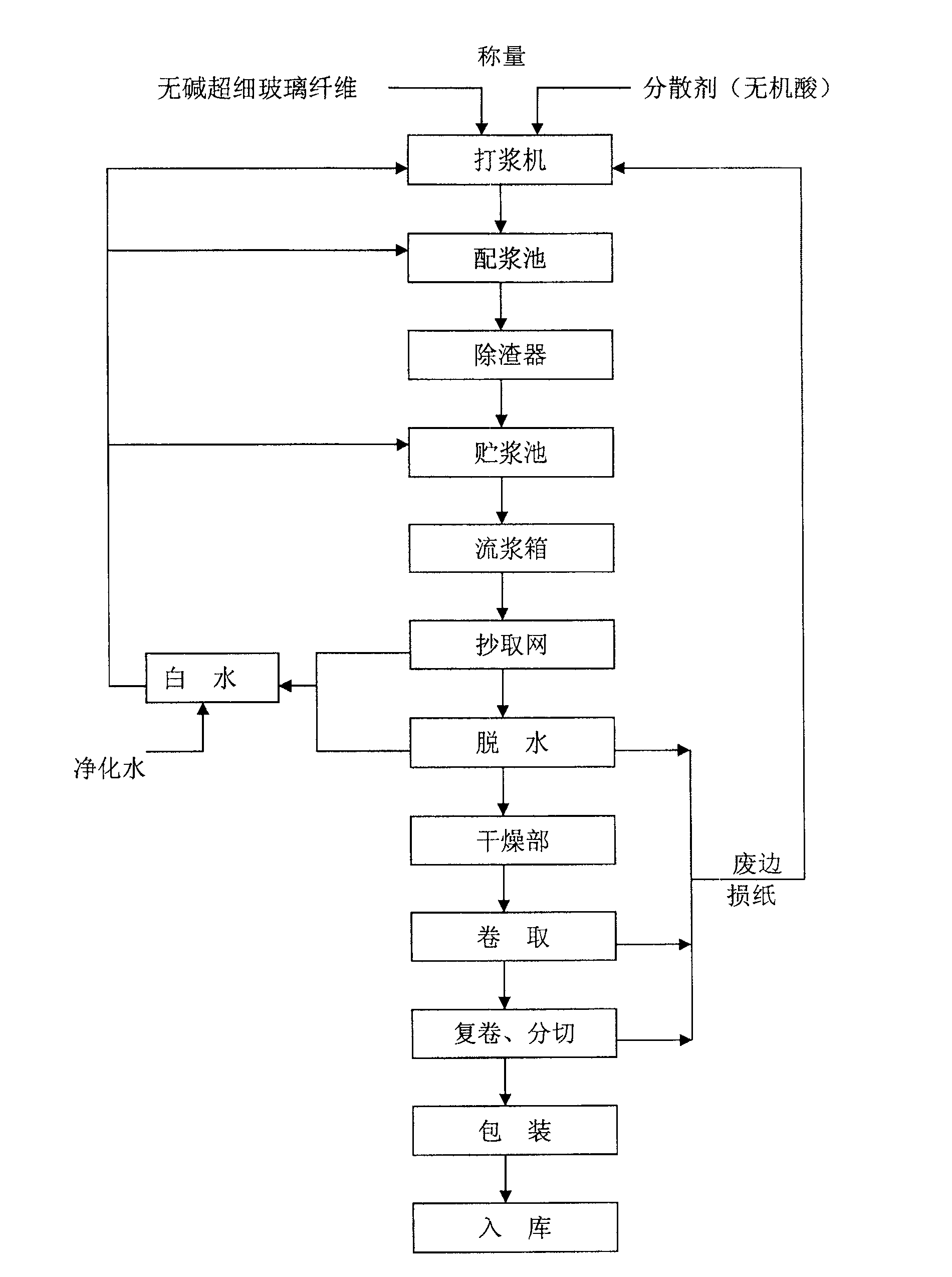Low-temperature thermal insulation paper preparation method
A low-temperature thermal insulation and multi-layer thermal insulation technology, applied in papermaking, textile and papermaking, synthetic cellulose/non-cellulose material pulp/paper, etc., can solve the problems of affecting product performance, increasing outgassing rate, and high comprehensive cost. Achieve long service life, increase contact thermal resistance, and good profiling
- Summary
- Abstract
- Description
- Claims
- Application Information
AI Technical Summary
Problems solved by technology
Method used
Image
Examples
Embodiment 1
[0033] The preparation of embodiment 1 low temperature insulation paper (referring to figure 1 )
[0034] (1) Add 100Kg of 49°SR (fiber diameter 0.1-1.0μm) ultra-fine alkali-free glass fiber into the beater and dilute it to 1.0% with water, add sulfuric acid to adjust the pH value to 2.5, and put it away after the fibers are all dispersed into single strands into the mixing pool;
[0035] (2) Continue to dilute the glass fiber put into the slurry mixing tank to 0.1% with white water, and add sulfuric acid to adjust the pH value to 2.5, and after stirring evenly, use a pump to send the slurry to the slurry storage tank after being treated by a conical slag remover;
[0036] (3) Pump the slurry from the slurry tank to the headbox, dilute it with white water to 0.05% again, and then take it online, after dehydration and pressing, it enters the drying tunnel for drying, and finally after trimming, stick it to the cylinder and coil it into rolls .
[0037] The above-mentioned fi...
Embodiment 2
[0039] Example 2 Preparation of Low Temperature Thermal Insulation Paper
[0040] (1) Add 40Kg of 49°SR (fiber diameter 0.1-1.0μm) alkali-free glass fiber into the beater, dilute it to 0.5% with water, add sulfuric acid to adjust the pH value to 2.5, and put the fiber into the compound after all the fibers are dispersed into a single fiber pulp pool;
[0041] Take 60Kg of 54°SR alkali-free glass fiber (fiber diameter is 0.1-1.0μm), add it into the beater, dilute it with water to a concentration of 0.5%, add sulfuric acid and adjust the pH value to 2.5, and put it into the compound after all the fibers are dispersed into single fibers. pulp pool;
[0042] (2) Continue to dilute the glass fiber put into the pulp mixing tank to 0.05% with white water, and add sulfuric acid to adjust the pH value to 2.5, and after stirring evenly, use a pump to send the slurry to the slurry storage tank after being treated by a conical slag remover;
[0043] (3) Pump the slurry from the slurry t...
Embodiment 3
[0046] Example 3 Preparation of Low Temperature Thermal Insulation Paper
[0047] (1) Put 40Kg of 49°SR (fiber diameter 0.1-1.0μm) alkali-free glass fiber into the beater and dilute it to 2.0% with water, add sulfuric acid to adjust the pH value to 3.0, and put the fiber into the compound after all the fibers are dispersed into a single fiber pulp pool;
[0048] Take 60Kg of 54°SR alkali-free glass fiber (fiber diameter is 0.1 ~ 1.0μm), add it into the beater, dilute it with water to a concentration of 2.0%, add sulfuric acid and adjust the pH value to 3.0, and put it into the compound after all the fibers are dispersed into single fibers. pulp pool;
[0049](2) Continue to dilute the glass fiber put into the slurry mixing tank to 0.5% with white water, and add sulfuric acid to adjust the pH value to 3.0, and after stirring evenly, use a pump to send the slurry to the slurry storage tank after being processed by a conical slag remover;
[0050] (3) Pump the slurry from the s...
PUM
| Property | Measurement | Unit |
|---|---|---|
| thickness | aaaaa | aaaaa |
| diameter | aaaaa | aaaaa |
| thickness | aaaaa | aaaaa |
Abstract
Description
Claims
Application Information
 Login to View More
Login to View More - R&D
- Intellectual Property
- Life Sciences
- Materials
- Tech Scout
- Unparalleled Data Quality
- Higher Quality Content
- 60% Fewer Hallucinations
Browse by: Latest US Patents, China's latest patents, Technical Efficacy Thesaurus, Application Domain, Technology Topic, Popular Technical Reports.
© 2025 PatSnap. All rights reserved.Legal|Privacy policy|Modern Slavery Act Transparency Statement|Sitemap|About US| Contact US: help@patsnap.com

